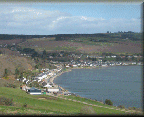Many references are made to the school cleaners and the attendance officers in the Management Committee Minutes books, but sometimes in Avoch the two posts were held by the same person.
In the regulations from the Minute Book of 1919 all the classrooms had to be thoroughly scrubbed with soap and water and the walls sprayed with disinfectant each month. The floors had to be sprinkled with wet sawdust and brushed daily while the windows had to be cleaned three times a year. For all this the cleaner was paid £15 a year!
Special recommendations for cleaning were given for certain epidemics. In 1913 after an epidemic of measles and cases of typhus, the cleaner was instructed to smoke the buildings with sulphur.
Throughout the 1920s the Medical Officer of Health called for improved cleaning of schools and improved wages for the cleaners. In 1910, “Dusmo” a cleaner, disinfectant and antiseptic arrived and was used universally in schools.
In the late 1940s, there was an acute shortage of cleaners which left teachers having to do the cleaning themselves. Lack of cupboards and piles of books lying around meant an accumulation of dust. The shortage of cleaners continued into the 1950s, but the use of electricity in schools meant less dust from open fires.
